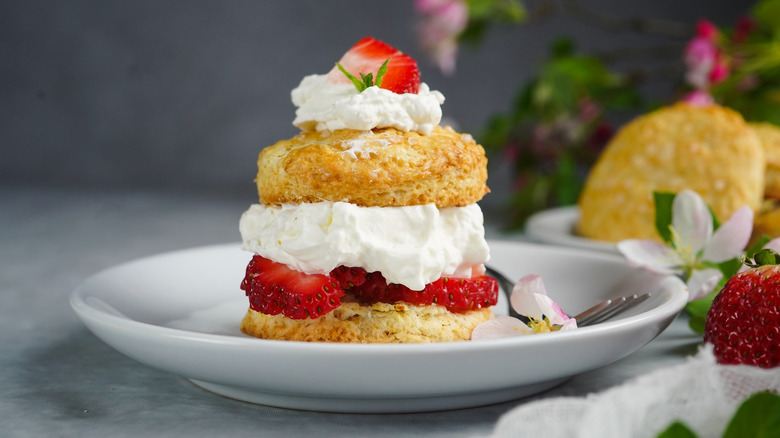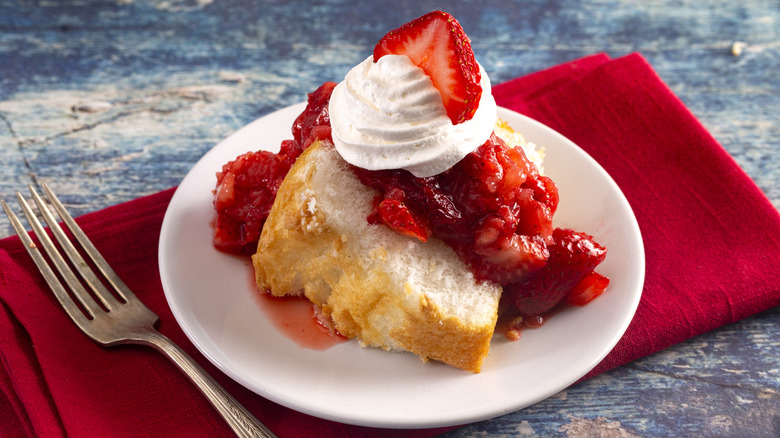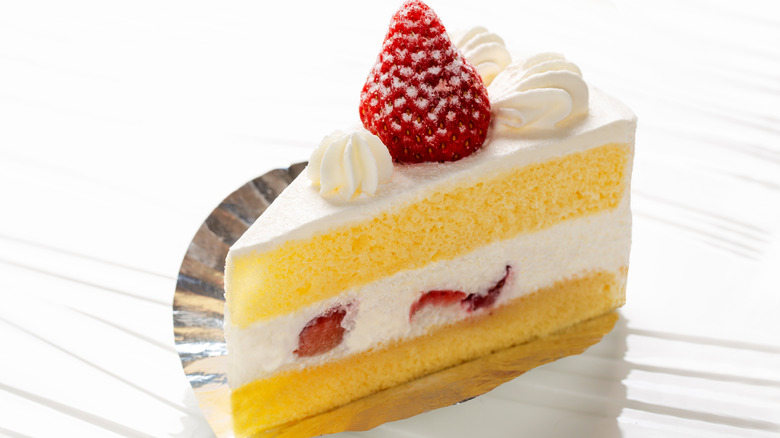The Delicious Evolution Of Strawberry Shortcake
Let's talk strawberry shortcake, and no, we don't mean the sweet little cartoon character with the absurdly oversized hat. The dessert for which she is named, that simple yet delectable union of juicy strawberries, flaky shortcake, and pillowy whipped cream, is equally worthy of American icon status. But despite being such a ubiquitous feature of spring and summer dining, it seems that shockingly little is actually known about where, when, and how this treat originated.
The aforementioned version, which you can make yourself from this quick and simple strawberry shortcake recipe appears to be an American original. The first recipe appeared in "Miss Leslie's Ladies New Receipt Book," published in 1847. There, it was referred to as strawberry cake, but the recipe for a flaky pastry is unmistakably shortcake. However, while this may mark the first recorded mention of strawberry shortcake, the dessert's roots stretch much further back, beginning with Native American strawberry desserts that later melded with the English shortcake, which evolved separately on the other side of the Atlantic. Its evolution has been complicated, but there's still plenty to make of it.
The origins of strawberry shortcake
Shortcake as it is typically served today, meaning a biscuit-like dessert, emerged in England. Its name has nothing to do with stature. Rather, the term "short" denotes a crisp, crumbly texture, as marked by the presence of fat, or "shortening" in the dough. It's unclear when shortcakes came to be, but the first known recipe appeared in 1588. Shortly thereafter, in 1602, William Shakespeare published "The Merry Wives of Windsor," which features a character named Alice Shortcake, evidence that the term was well-known by that time.
The first shortcakes probably didn't feature strawberries. While there were wild strawberries in Europe at least as far back as Roman Times, the plump, juicy fruit we know today evolved from two American species: a unique white strawberry from South America which was crossbred with a North American variety. Before Europeans arrived, Native Americans mixed strawberries with cornmeal to bake a sweet bread, one that English colonists later sampled and were potentially inspired by. Later on, an early version of what we might call strawberry shortcake featured a flaky pie-like crust split in half, filled with berries, and covered in frosting.
Strawberry shortcake takes different forms
As you can see, the definition of strawberry shortcake has been anything but consistent throughout the course of history. Over the years, sponge cake, angel food cake, and puff pastry have all been used as the base for strawberry desserts. At some indeterminate point, frosting gave way to whipped cream, and by the time "Miss Leslie's Ladies New Receipt Book" came out, the modern understanding of strawberry shortcake seemed to have solidified. But even today, there are interactions of the treat that look very different from the one Americans know.
Japanese Christmas cake traces its origins to a version of strawberry shortcake. Christmas cake is widely-consumed during the holiday season in Japan, inspired by Western desserts (known as "yogashi" in Japanese). Yogashi historically served as a status symbol, since classical Western ingredients like milk and butter were hard to come by in pre-WWII Japan. In 1912, a Japanese chef named Fujii Rin'emon traveled to the U.S. and discovered an iteration of strawberry shortcake that used sponge cake, strawberries, and whipped cream. Back in his home country, he developed his own recipe, starting a company that specialized in yogashi when few others did. After WWII, as Japan and the U.S. mended their relationship and engaged in more trade, yogashi became more accessible, and this unique descendent of strawberry shortcake became just as popular as its ancestor is in the States. It's so emblematic, that it even inspired the cake emoji on your phone.


